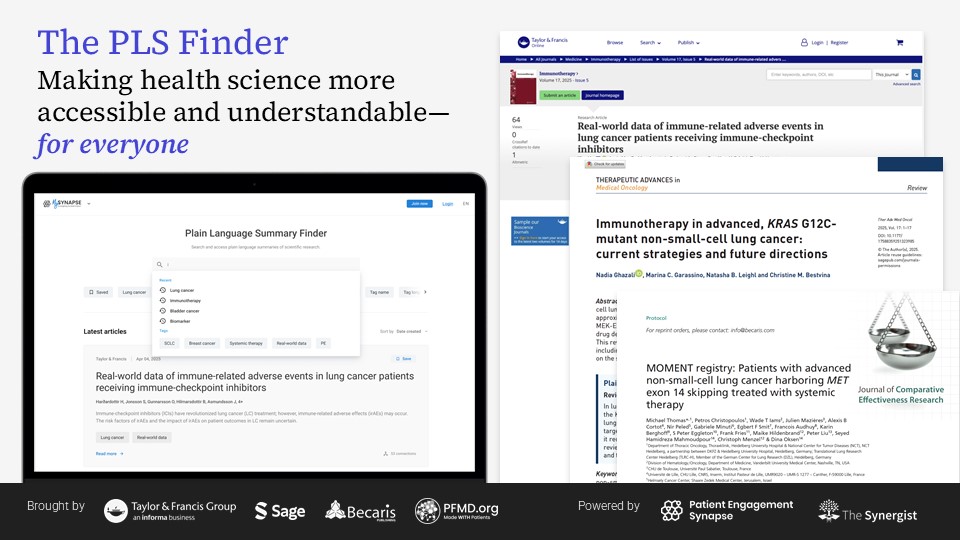Plain language content helps to democratize scientific knowledge by presenting information in a way that is easy to understand. However, it’s notoriously difficult to find and access plain language content using traditional scholarly indexing services like PubMed. Recognizing an opportunity to improve access to health science research for everyone, a group of publishers, in collaboration with The Synergist, are working together to create The PLS Finder – a comprehensive aggregator of abstract style plain language summaries (PLS) and standalone plain language summaries of publications (PLSPs).
I sat down with the people behind the project to find out more about how The PLS Finder will improve access to understandable research information. Here’s what they said …

PLS, plain language summary(ies).
Take us back to the beginning. What inspired The PLS Finder?
Joanne: Back when we set up standalone PLSPs [at Future Science Group], we created the plainlanguagesummaries.com website, and we were finding there was a lot of use of that, but it was limited to standalone PLSPs published by [Future Science Group].
Probably 4 years ago, we started thinking, “can we expand on this resource and find some way of aggregating plain language content?” We recognized that, as well as the PLSPs, there were many other publications and different journals that were publishing abstract-style PLS.
Through discussions with other stakeholders, we found that others were thinking the same. That’s where the idea came about.
Kelly: At Taylor & Francis, we felt it was our responsibility to not only make sure that PLS were encouraged and published, but also easily accessible and discoverable for all audiences.
Sam: Then there was “the ISMPP moment”.
Joanne: That’s right! We all got together at ISMPP [the International Society for Medical Publication Professionals] Annual a couple of years ago, and Hamish said, “shall we resurrect this as a concept?” We all thought “yes!”. Rather than just one publisher trying to do it, it made more sense to do it as a collaboration and that’s when our cross-publisher initiative started.
Before we got in touch with The Synergist, we tried to work out if there was some way that we could set up a not-for-profit.
Sam: We were worried that if we as people left our organizations, The PLS Finder wouldn’t carry on or that there would have to be changes of governance, so we started looking for a third party who might help us run it. The hardest part for us was finding the right partner who could do this in a way that we believe tallied with the values of what The PLS Finder should be and was able to provide us with a platform that we believed was good and would be developed properly.
Kelly: We felt a third-party partner would be best because, as a cross-publisher initiative, The PLS Finder needed to remain publisher agnostic, with no one publisher running the platform. Partnering with The Synergist aligned with our vision to develop a sustainable resource supported by a patient-focused organization.
Hamish: PFMD [brought to fruition by The Synergist] were our first choice when we were thinking about who we could give this to. It was the name that made the most sense. When we met with them, it was so exciting to see that they got it straight away.
What was it that was of interest to The Synergist?
Maria: At The Synergist, we leverage multistakeholder collaboration to address societal challenges, one of which is patient engagement in healthcare. We want patients and caregivers to be meaningfully involved in healthcare decision making, and having plain language information readily accessible is very aligned with that goal.
The PLS Finder will be housed on PFMD’s Patient Engagement Synapse digital platform. This is an existing community space with over 8 500 members, where different stakeholders in health and life sciences can access resources and materials.
We’re thrilled to offer a home for The PLS Finder and bridge our community with the community that the publishers have been working with. There’s value for patients, but there’s also value for other stakeholders like healthcare professionals, policy-makers and investors.
“Being able to put The PLS Finder into the Synapse platform where there’s already a diverse user community means we’re meeting people where they’re at.”
Maria Marano
It’s about doctors having easy access to research materials to keep up with the tremendous number of advances in the medical field; for healthcare investors or health policy-makers, being able to quickly peruse what’s happening and familiarize themselves with certain therapeutic areas or conditions that they’re supposed to be making decisions on. And again, empowering the patient community to be active participants both in their healthcare decisions and shaping health systems.
Rachel: Access to reliable information that can be read and understood quickly is one of the main challenges for these stakeholder groups. Having publishers as its basis makes The PLS Finder really strong and, hopefully, will encourage other publishers to get on board and embrace their own PLS initiatives.
“We want to start this revolution … of trying to bring plain language content to a wider audience, but we want to encourage other publishers to be a part of this as well.”
Sam Cavana
Sam: We want to start this revolution, so to speak, of trying to bring plain language content to a wider audience. We want to encourage other publishers to be a part of this as well. You know, patients don’t know PubMed.
Rachel: Even then, they [PLS and PLSPs] can still be difficult to find.
Joanne: We can’t even find our own PLS sometimes, so we know that there is this unmet need.
Sophie: Absolutely. I had an email come through right at the end of last week from one of our Open Pharma Members saying “I’m trying to use PubMed to find all of the PLSPs that have ever been published. How can I do that?”. I was sat at my desk thinking, “how do I answer this in 15 minutes?!” I don’t – I don’t!
What will The PLS Finder look like?
Sam: The PLS Finder will be a free-to-access indexing service for PLS abstracts and PLSPs by the founding publishers Sage, Becaris and Taylor & Francis, but with the openness to add other publishers who want to come on board.
Although we keep calling it The PLS Finder, we’re finding – no pun intended – that might not be the final name of this platform.
Hamish: Unless people tell us it’s the best name! We are still very much in the prototyping phase. The idea is, eventually, to consult stakeholders, co-design with patients and use their insights to help inform some of the user design to what they would like to see, to be able to locate the information that they need.
For us, it’s crucial that the content has been peer reviewed. We really don’t want to be dealing with and indexing non-peer-reviewed content because then we could be providing information that might not be reliable.
Kelly: Yes, with the proliferation of mis- and disinformation online, especially on social media, The PLS Finder needs to provide high-quality content that audiences trust and that they can use to make better decisions about their healthcare.
“For us it’s crucial that the content has been peer reviewed. We really don’t want to be … providing information to people that might not be reliable”
Hamish McDougall
Maria: Right now, we have some ideas [for The PLS Finder] from initial conversations, and the next steps would be to use The Synergist’s co-creation process, collaborating with different stakeholders to roll up our sleeves and work together to validate a design before developing a beta version.
One of the unique features of The PLS Finder will be a personalized user experience. Because The PLS Finder is being built into the existing Synapse platform, the aim is for users to get tailored recommendations based on their interests, so it’ll be personalized to what they’re interested in learning.
It will allow users to select what info they receive based on their health or their interests in healthcare.
Sam: There will be a non-user area where, if you don’t want that content to be fed to you, you’ll be able to access it anyway without signing in.
Sophie: So, the open site would function as an indexing service, but there’s also the option of tailoring the content – that customization – as well?
Sam: Yeah, exactly.
We’ve mentioned abstract style PLS and PLSPs – are you focusing on those content types only or will you expand in the future to, for example, videos and podcasts?
Joanne: Initially we’re just going to concentrate on PLS and PLSPs. Because of the volume of information, we need to trial it in stages, so we’ll just have content published by Becaris, Sage and Taylor & Francis to begin.
Then, we want to try and encourage more publishers to come onboard. We want to inspire a little bit of FOMO [fear of missing out] with other publishers. If they’re not doing PLS then they should be doing PLS, and they should have them on The PLS Finder.
We’re aware of copyright issues, and we want more publishers to be involved so they have to opt in to have their plain language content indexed.
Sam: There is also a lot of work that we have to do in the background to standardize things across the publishers. You wouldn’t believe how difficult that actually is.
Joanne: You can’t find every PLS on PubMed at the moment, so there’s something wrong with everyone’s metadata. Once we’ve figured it out, then we’ll develop some best practices, and we can share those with other publishers and ultimately make PLS and PLSPs a lot more discoverable.
Kelly: Our medical publishing community has done a lot of work to create consensus on best practices for developing and publishing PLS. Now we know an important next step is to introduce standardized plain language content tagging and metadata.
“The PLS Finder will massively accelerate PLS [and] help to push the point about all PLS being free to access.”
Rachel Jenkins
Rachel: In my head, The PLS Finder will massively accelerate PLS as a whole because it’s going to bring a lot more eyes to them. Other publishers will hopefully want to get involved, and we’re going to have to align best practices. I think it will help to push the point about all PLS being free to access – because I’ve had people tell me sometimes that they aren’t even available in front of a registration wall – but they’re going to have to be if they’re on The PLS Finder.
Joanne: Some publishers don’t know where to put them [abstract-style PLS], so they just don’t recognize them.
You’ve talked about the metadata behind the scenes and aligning that. Are there other ways you hope this platform will promote best practice in plain language content?
Hamish: It would be really nice if the platform added enough validation to the whole concept of PLS and PLSPs that people wanted to standardize and work in the same ways, and I think that’s where the best practice guidance really comes into play.
The PLS Finder will be very reliant on metadata. Having guidelines about the tags that you need for the content to be picked up by The PLS Finder will be part of the development process as well.
Sam: Originally, we were planning on trying to do it manually and realized it was an impossible task. That’s why we’re talking so much about metadata. We want The PLS Finder to update as soon as possible.
Joanne: It’s not manual creation, it’s automatic curation of content.
Kelly: Absolutely – we have metadata on our minds! The PLS Finder is only as good as the content it indexes. An automatic process that consistently finds and curates PLS and PLSPs is a critical part of that. Beyond metadata standardization, the platform will make it easier for everyone to critically evaluate PLS and PLSPs, which will encourage refinement of best practices for writing and development.
Is there anything that publishers who are already publishing PLS, or even those who are not, could do to take a step towards getting on board with The PLS Finder?
Sam: I don’t want to sound repetitive, but you know what they need to do, Sophie? It’s the metadata!
Hamish: It is!
Joanne: Oh, yeah.
Hamish: The content has to have the PLS tag in the metadata. The abstract-style PLS are low-hanging fruit. If you have it, you want people to be able to see it. People can disagree on what the best way to format it might be, but the first thing is, “can people actually see it? Can people find it?”.
Joanne: And there are also those publishers who don’t even publish PLS. There are those groups of journals and/or publishers who do not think that patients should be reading journal articles; that’s still a barrier that needs to be overcome. Journals do publish content for multiple readers; it’s not just for scientists.
Kelly: That opinion – that patients should not be reading journal articles – doesn’t consider how open access has changed access to research. More and more scientific content is fully and freely accessible to anyone who has internet access. Patients already find and read journal articles. It benefits everyone if research findings are easy to understand and contribute to better health care and outcomes.
Sam: My mum is always looking at articles online. Some of it she can understand, some of it she can’t understand, but the problem is that she doesn’t know whether it is from a trusted source.
To the common user, something like a predatory publisher doesn’t even feature in their lexicon – it’s not something they even consider. I know I’m slightly going off topic here, but to be serious, that is a real problem.
Patients need to see content that is peer reviewed and from a reputable source, but it can often be behind a paywall and patients aren’t spending $60, $80, $100 just to read a paper. They’ll just click somewhere else.
“There are those groups of journals and/or publishers who do not think that patients should be reading journal articles … Journals do publish content for multiple readers; it’s not just for scientists.”
Joanne Walker
Maria: People want to be supporting their health and want to feel empowered. It’s difficult to get a diagnosis and not feel like there’s something you can do. Patients are going to look for that information regardless.
We can give people that chance to do their own work and know that they are contributing to their health, but rather than going to the full internet – where who knows what’s going to be sent to them – they go to The PLS Finder, and they can find reliable information. It’s about giving empowerment and autonomy to people while providing direction to peer-reviewed, reliable content.
Sophie: Something we’ve been talking about within Open Pharma is, instead of trying to discredit the predatory publishers and the misinformation, the ‘bad’ science, elevate the good science and the reliable sources and crowd out the bad actors. It sounds like that’s the approach that The PLS Finder is going to take. Research is available in an accessible format, written so that anyone can understand it, but it’s also been peer reviewed, and you can access the source article on a single click of a link.
Joanne: Exactly! And in the AI [artificial intelligence] era, having these published PLS that have been peer reviewed is so important because you don’t want patients plugging in a paper and getting an AI-generated PLS. It could be out of context, it could lie, it could make up the data, it could even get the conclusion wrong. People want to have PLS that are accurate, trusted, you know, all the “buzzwords” that make it trustworthy. That’s why The PLS Finder will be so important.
What are your immediate and longer-term next steps?
“It benefits everyone if research findings are easy to understand … ”
Kelly Soldavin
Hamish: One of our priorities when we launched this was to make it cross-publisher, to be independent of any one publishing organization and to be multistakeholder.
The next steps for us are about seeking finance to launch us off the ground and make sure that it has the development funds that it needs. We are really looking for it to be a multistakeholder project. The more contributors across agencies, across industry and across publishers we have, the better.
Sam: We are welcoming to other good-faith publishers; our door is open for others to join us. If Wiley wants to come along, if Elsevier wants to come along, whoever, they’re welcome to.
We want it to be a long-term proposition as well. This is not something that we’re just going to do for a short amount of time. We hope for this to be funded in a way that it will be multi-year and as permanent as possible.
If you want to learn more about The PLS Finder or are interested in getting involved, visit The PLS Finder initiative page.
The views expressed in this blog post are those of the authors and do not necessarily reflect those of Open Pharma or its Members and Supporters.
Hamish McDougall is Senior Publishing Solutions Manager at Sage, where he introduced the publication of PLSPs and created the Patient accessible research microsite. Hamish is also the Co-Chair of the ISMPP digital/visual communications committee.
Joanne Walker is Co-Founder and Publishing Director at Becaris Publishing, with over 25 years of experience in medical publishing. At Becaris Publishing, Joanne coordinates the editorial strategy for The Evidence Base and is committed to ensuring that all content published in the Journal of Comparative Effectiveness Research and on The Evidence Base is accessible, engaging and clearly communicated, whether through plain language summaries in the journal or visual infographics on the website. Previously, as Head of Publishing Solutions at Future Science Group, Joanne led the development of a pioneering initiative to publish PLSPs as peer-reviewed, standalone articles, helping to improve transparency and understanding of medical research.
Kelly Soldavin is Head of Managed Journals at Taylor & Francis, leading a team of in-house editors who manage clinical medicine and life sciences journals. Kelly is passionate about patient engagement and collaboration in publishing and co-led the initiative to launch PLS and PLSPs in Taylor & Francis journals. This initiative also led to the creation of Taylor & Francis’s PLS and PLSP peer reviewer guidelines and guidance for patient authors.
Maria Marano is Associate Program Director at The Synergist, a global, not-for-profit organization that facilitates multi-stakeholder collaborative programmes to address complex societal issues.
Rachel Jenkins is Head of Plain Language Summaries at Taylor & Francis, where she oversees the PLS initiative across their journal portfolio.
Sam Cavana is Head of Publishing Solutions at Taylor & Francis, working to bring innovative solutions to manuscripts. Sam has been keen to increase patient engagement and collaboration in publishing and increasing this with the launch of The PLS Finder.
Sophie Nobes is a Senior Medical Writer at Oxford PharmaGenesis and Lead of the Open Pharma plain language summary and discoverability working group.
The authors would like to thank Clare Cook for her contributions to The PLS Finder project.
Editor’s note
Future Science Group was acquired by Taylor & Francis in 2023.

![A person is submerged in a mangrove. Their hands are raised above the water.]]](https://www.openpharma.blog/wp-content/uploads/2025/01/pexels-edurawpro-21588525-150x100.jpg)




